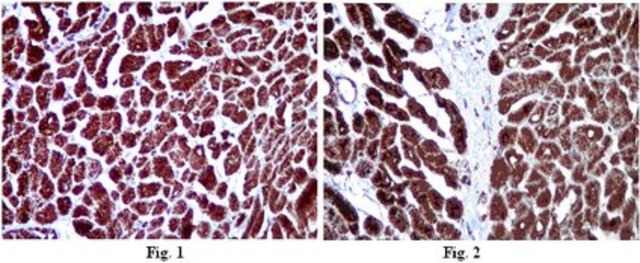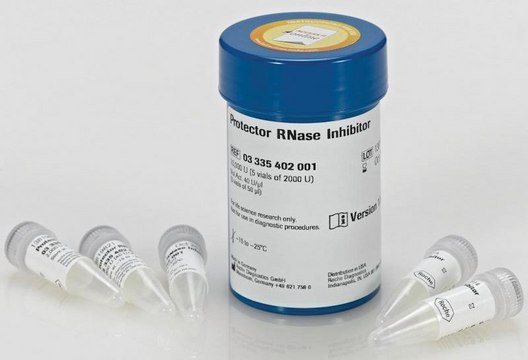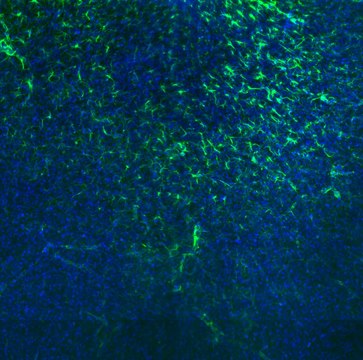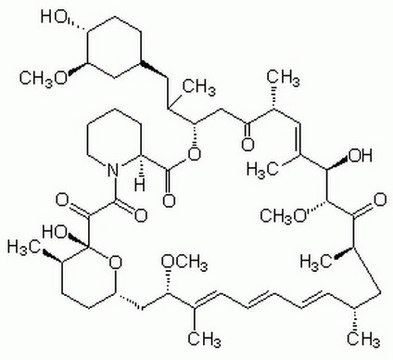推荐产品
生物来源
human
质量水平
重组
expressed in E. coli
描述
0.1 mg recombinant human CD274 in 20 mM Tris-HCl buffer, containing NaCl, KCl, EDTA, L-arginine, DTT and glycerol.
无菌性
Filtered sterilized solution
方案
≥90% (SDS-PAGE)
表单
liquid
包装
pkg of 100 μg
浓度
0.5 mg protein/mL
技术
cell culture | mammalian: suitable
登记号
NP_054862.1
运输
dry ice
储存温度
−20°C
基因信息
human ... CD274(29126)
应用
Coating a plate well (6 well plate) with this recombinant CD274 protein in a specific culture medium at 5-10 μg/well allows for use 1) as human T and B cells activation/differentiation studies or 2) as a potential biomarker protein for infectious diseases in vitro or 3) for auto-immuno disease diagnostic development.
Use this procedure as a guideline to determine optimal coating conditions for the culture system of choice.
1.Thaw CD274 and dilute to desired concentration using serum-free medium or PBS. The final solution should be sufficiently dilute so the volume added covers the surface evenly (5-10 μg/well, 6 well plate).
2.Add appropriate amount of diluted material to culture surface.
3.Incubate at room temperature for approximately 1.5 hours.
4.Aspirate remaining material.
5.Rinse plates carefully with water and avoid scratching bottom surface of plates.
6.Plates are ready for use. They may also be stored at 2-8 °C damp or air dried if sterility is maintained.
Use this procedure as a guideline to determine optimal coating conditions for the culture system of choice.
1.Thaw CD274 and dilute to desired concentration using serum-free medium or PBS. The final solution should be sufficiently dilute so the volume added covers the surface evenly (5-10 μg/well, 6 well plate).
2.Add appropriate amount of diluted material to culture surface.
3.Incubate at room temperature for approximately 1.5 hours.
4.Aspirate remaining material.
5.Rinse plates carefully with water and avoid scratching bottom surface of plates.
6.Plates are ready for use. They may also be stored at 2-8 °C damp or air dried if sterility is maintained.
序列
MASMTGGQQMGRGHHHHHHGNLYFQG^GEFFTVTVPKDLYVVEYGSNMTIECKFPVEKQLDLAALIVYWEMEDKNIIQFVHGEEDLKVQHSSYRQRARLLKDQLSLGNAALQITDVKLQDAGVYRCMISYGGADYKRITVKVNAPYNKINQRILVVDPVTSEHELTCQAEGYPKAEVIWTSSDHQVLSGKTTTTNSKREEKLFNVTSTLRINTTTNEIFYCTFRRLDPEENHTAELVIPELPLAHPPNER
制备说明
The extracellular domain of recombinant human CD274 (19-238 aa, derived from BC074984) was constructed with codon optimization and expressed with a small T7-His-TEV cleavage site Tag (29aa) fusion at its N-terminal and expressed in E. coli as inclusion bodies. The final product was refolded using our unique “temperature shift inclusion body refolding” technology and chromatographically purified.
储存分类代码
10 - Combustible liquids
WGK
WGK 2
闪点(°F)
Not applicable
闪点(°C)
Not applicable
法规信息
常规特殊物品
Shoba Amarnath et al.
Science translational medicine, 3(111), 111ra120-111ra120 (2011-12-03)
Immune surveillance by T helper type 1 (T(H)1) cells is not only critical for the host response to tumors and infection, but also contributes to autoimmunity and graft-versus-host disease (GVHD) after transplantation. The inhibitory molecule programmed death ligand 1 (PDL1)
Daria Trabattoni et al.
Blood, 101(7), 2514-2520 (2002-12-07)
The ligation of programmed death-ligand 1 (B7-H1) to T cells results in the preferential production of interleukin 10 (IL-10). We investigated if B7-H1 would be up-regulated in HIV infection, a disease characterized by increased IL-10 production, by measuring B7-H1, B7-1
Yujia Cao et al.
Cancer research, 71(14), 4737-4741 (2011-07-07)
B7-H1 (CD274), a member of the B7 family of coinhibitory molecules, is often induced in human tumors and its expression is closely correlated with a poor prognosis or higher malignancy grade. Tumor-associated B7-H1 is implicated in mechanisms of immune escape.
Jun Yang et al.
Journal of immunology (Baltimore, Md. : 1950), 187(3), 1113-1119 (2011-06-24)
The programmed death ligand 1 (PDL1)/programmed death 1 (PD1) costimulatory pathway plays an important role in the inhibition of alloimmune responses as well as in the induction and maintenance of peripheral tolerance. It has been demonstrated recently that PDL1 also
我们的科学家团队拥有各种研究领域经验,包括生命科学、材料科学、化学合成、色谱、分析及许多其他领域.
联系技术服务部门






